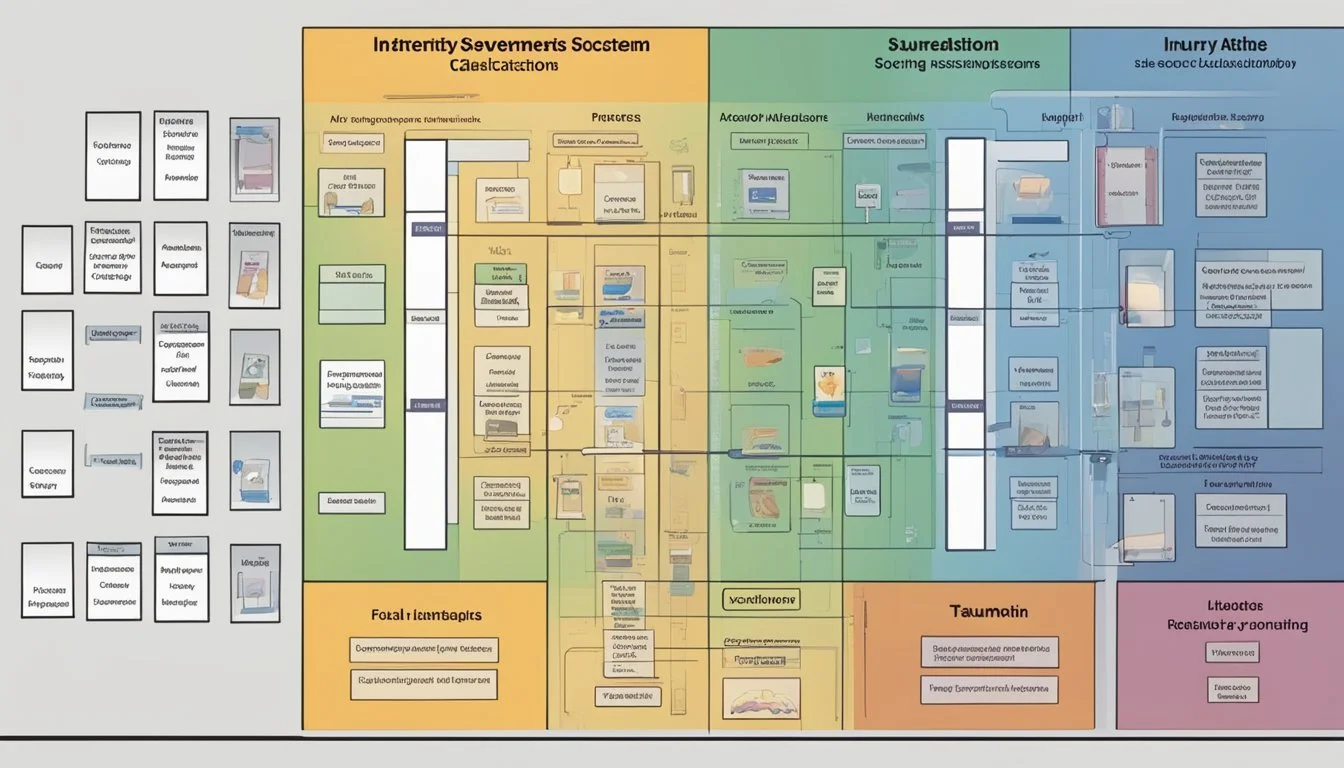Understanding the World Health Organization Trauma Classification System
Trauma classification systems play a crucial role in healthcare, providing standardized methods for categorizing and describing injuries. These systems enable medical professionals to communicate effectively, guide treatment decisions, and facilitate research in the field of traumatology. The World Health Organization (WHO) has developed comprehensive trauma classification frameworks to ensure consistent data collection and reporting across different healthcare settings globally.
One of the primary tools in this area is the International Classification of Diseases (ICD), which includes codes for various types of injuries and their external causes. The WHO also supports the International Classification of External Causes of Injury (ICECI), offering more detailed categorization of injury mechanisms and circumstances. These classification systems help healthcare providers, researchers, and policymakers analyze injury patterns, identify risk factors, and develop targeted prevention strategies.
By utilizing standardized trauma classifications, healthcare professionals can improve patient care, enhance epidemiological studies, and contribute to the development of evidence-based treatment protocols. The ongoing refinement of these classification systems reflects the evolving understanding of trauma and its impact on global health.
Understanding Trauma and Classification
Trauma classification provides a structured approach to categorizing injuries, enabling healthcare professionals to assess severity and determine appropriate treatment protocols. Accurate classification is crucial for effective patient care and research in trauma medicine.
Definition and Importance of Trauma Classification
Trauma refers to physical injury caused by external forces. Classification systems organize these injuries based on specific criteria, facilitating communication among medical professionals and guiding treatment decisions.
These systems help standardize injury descriptions, allowing for consistent assessment across different healthcare settings. They also aid in predicting patient outcomes and allocating resources efficiently.
Trauma classification plays a vital role in research, enabling comparison of treatment methods and outcomes across studies. It supports quality improvement initiatives in trauma care by providing benchmarks for performance evaluation.
Types of Trauma: Blunt and Penetrating Injury
Blunt trauma results from impact with a dull object or surface. It can cause internal injuries without breaking the skin. Common examples include car accidents, falls, and sports injuries.
Blunt trauma may lead to:
Contusions
Fractures
Internal organ damage
Penetrating trauma involves objects piercing the body, creating an open wound. This type includes gunshot wounds, stabbings, and impalements.
Penetrating injuries can cause:
Direct tissue damage
Blood vessel injuries
Infection risks
Both types of trauma require distinct assessment and treatment approaches. Healthcare providers use specific classification systems for each to guide their clinical decision-making and ensure appropriate care for injured patients.
Injury Severity Scoring Systems
Trauma scoring systems provide standardized methods for assessing injury severity and predicting patient outcomes. These tools play a crucial role in triage, treatment planning, and research.
Glasgow Coma Scale (GCS)
The Glasgow Coma Scale assesses neurological function in trauma patients. It evaluates eye opening, verbal response, and motor response. Scores range from 3 to 15.
Eye opening is scored from 1 to 4:
No eye opening
Eye opening to pain
Eye opening to verbal command
Spontaneous eye opening
Verbal response is scored from 1 to 5:
No verbal response
Incomprehensible sounds
Inappropriate words
Confused conversation
Oriented
Motor response is scored from 1 to 6:
No motor response
Extension to pain
Flexion to pain
Withdrawal from pain
Localizing pain
Obeys commands
Lower scores indicate more severe impairment. GCS is widely used but has limitations in intubated or sedated patients.
Abbreviated Injury Scale (AIS)
The Abbreviated Injury Scale classifies injuries by body region and severity. It uses a 6-point scale:
Minor
Moderate
Serious
Severe
Critical
Unsurvivable
AIS covers nine body regions: head, face, neck, thorax, abdomen, spine, upper extremity, lower extremity, and external. It provides a standardized language for describing injuries.
The AIS forms the basis for other scoring systems like the Injury Severity Score. Its main limitation is the subjective nature of injury classification.
Injury Severity Score (ISS) and New Injury Severity Score (NISS)
The Injury Severity Score uses AIS scores to calculate an overall severity score. It considers the three most severely injured body regions.
ISS calculation:
Determine the highest AIS score in each body region
Select the three highest AIS scores
Square each of these scores
Sum the squares
ISS ranges from 1 to 75. A score over 15 indicates major trauma. ISS has limitations in multiple injuries to a single body region.
The New Injury Severity Score addresses this by using the three highest AIS scores regardless of body region. NISS may better predict mortality in some cases.
Revised Trauma Score (RTS)
The Revised Trauma Score assesses physiological parameters:
Glasgow Coma Scale
Systolic Blood Pressure
Respiratory Rate
Each parameter is assigned a value from 0 to 4. The RTS is calculated using a weighted sum of these values.
RTS = 0.9368 * GCS + 0.7326 * SBP + 0.2908 * RR
Scores range from 0 to 7.8408. Lower scores indicate more severe injuries. RTS is useful for triage and outcome prediction.
Trauma and Injury Severity Score (TRISS)
TRISS combines anatomical and physiological scoring to predict survival probability. It uses ISS, RTS, patient age, and injury mechanism (blunt or penetrating).
TRISS employs a logistic regression equation to calculate survival probability. The coefficients vary based on injury mechanism.
TRISS is widely used for trauma research and quality assessment. Its limitations include reduced accuracy in certain patient subgroups and reliance on the ISS.
Advanced Scoring Systems
Newer systems aim to improve upon traditional scores. Examples include:
Trauma Mortality Prediction Model (TMPM): Uses ICD-9 codes to predict mortality
International Classification of Diseases Injury Severity Score (ICISS): Based on survival risk ratios from large trauma databases
These systems offer improved accuracy but may be more complex to implement. They often require large datasets and sophisticated statistical techniques.
Advanced systems continue to evolve, incorporating more variables and machine learning algorithms to enhance predictive power.
Application of Trauma Classifications in Medical Practice
Trauma classifications play a crucial role in standardizing patient care, guiding treatment decisions, and improving outcomes for severely injured patients. These systems enable healthcare providers to effectively assess injury severity, allocate resources, and determine appropriate levels of care.
Triage and Field Triage
Field triage is essential for identifying severely injured patients and directing them to appropriate trauma centers. Emergency medical services use triage protocols based on physiological criteria, anatomic injury patterns, and mechanism of injury. These protocols help determine the need for transport to a trauma center versus a non-trauma hospital.
Triage systems often incorporate injury severity scores to rapidly assess patients. The Revised Trauma Score, for example, considers vital signs like respiratory rate, systolic blood pressure, and Glasgow Coma Scale. This score helps predict mortality and guides transport decisions.
Field triage protocols also consider factors like age, anticoagulant use, and pregnancy status. These elements can influence injury severity and required resources.
Patient Assessment and Care in ICU
In the intensive care unit (ICU), trauma classifications guide patient assessment and treatment planning. The Acute Physiology and Chronic Health Evaluation (APACHE) score is widely used to assess ICU patients' severity of illness.
APACHE incorporates physiological variables, age, and chronic health conditions. It helps predict mortality risk and guides resource allocation.
Other scoring systems, like the Injury Severity Score (ISS), are used to quantify anatomical injuries. The ISS considers injuries to different body regions and provides an overall score of injury severity.
These classifications help ICU teams:
Prioritize interventions
Estimate prognosis
Guide treatment intensity
Facilitate communication between healthcare providers
Trauma Centers and Levels of Care
Trauma center designations (Levels I-V) are based on available resources and capabilities. This system ensures that patients receive care appropriate to their injury severity.
Level I centers:
Provide comprehensive care for all injuries
Have 24/7 in-house trauma surgeons
Conduct research and education
Level II centers:
Offer similar services to Level I
May lack some subspecialty services
Level III-V centers:
Provide initial stabilization
Transfer complex cases to higher-level centers
Pediatric trauma centers specialize in caring for injured children. They have specialized equipment and staff trained in pediatric trauma care.
This tiered system optimizes resource utilization and ensures that severely injured patients receive appropriate care.
Advanced Trauma Life Support (ATLS)
ATLS is a standardized approach to trauma patient care. It uses a systematic ABCDE (Airway, Breathing, Circulation, Disability, Exposure) assessment to prioritize life-threatening injuries.
Key ATLS principles:
Primary survey: Rapid identification of immediate threats to life
Secondary survey: Detailed head-to-toe examination
Definitive care: Addressing specific injuries
ATLS incorporates trauma classifications to guide treatment decisions. For example, the Glasgow Coma Scale helps assess neurological status and determine the need for intubation or neurosurgical intervention.
ATLS protocols are regularly updated based on new evidence. They provide a common language and approach for trauma care across different healthcare settings.
Evaluating Outcomes and Quality in Trauma Care
Trauma care quality assessment involves analyzing patient outcomes, implementing quality assurance programs, and conducting research to improve care standards. These efforts aim to reduce morbidity and mortality while enhancing overall patient care.
Trauma Quality Assurance Programs
Quality assurance programs in trauma care focus on continuous performance improvement. These programs often include peer review processes to evaluate patient care and identify areas for enhancement. Regular audits assess adherence to established protocols and guidelines.
Trauma centers implement quality indicators to measure various aspects of care. These indicators may include response times, appropriate use of diagnostic tools, and adherence to treatment protocols. Patient outcomes, such as survival rates and functional recovery, are key metrics in quality assessment.
Multidisciplinary teams review cases to identify potential issues and develop strategies for improvement. This collaborative approach ensures comprehensive evaluation of care processes.
Research and Data in Trauma Outcomes
Research plays a crucial role in advancing trauma care. Studies published in journals like the Journal of Trauma provide valuable insights into best practices and innovative treatments.
Data collection and analysis are essential components of trauma outcomes research. Trauma registries compile detailed information on patient demographics, injury mechanisms, treatments, and outcomes. This data allows for benchmarking and identification of trends in trauma care.
Researchers investigate factors influencing patient outcomes, such as the impact of pre-hospital care, timing of interventions, and treatment modalities. These studies help refine trauma care protocols and guide resource allocation.
Multicenter collaborations facilitate large-scale research projects, providing robust evidence to inform clinical practice and policy decisions in trauma care.
Additional Considerations in Trauma Classification
Trauma classification systems must account for various patient populations and global applications. Age-specific factors and international adaptations play crucial roles in developing comprehensive classification frameworks.
Pediatric vs Adult Trauma Classification
Pediatric trauma classification differs from adult systems due to unique physiological and anatomical considerations. Children's bodies respond differently to injuries, necessitating specialized assessment tools. Pediatric trauma centers use modified scoring systems that account for age-specific vital signs and developmental stages.
Surgeons and allied health professionals must be trained in these differences to provide appropriate care. For example, pediatric Glasgow Coma Scale adaptations exist for infants and young children who cannot verbalize responses. Bone healing rates and growth plate considerations also factor into pediatric trauma classification.
International Classification and Adaptations
The International Classification of Diseases (ICD) provides a standardized global framework for trauma classification. However, regional adaptations are often necessary to account for local healthcare systems and resources.
Trauma centers worldwide may modify classification systems based on available technology and expertise. Some countries develop national trauma registries with customized data points. These adaptations help improve local trauma care while maintaining international comparability.
Nursing and allied health professionals play key roles in implementing these adapted classification systems. Regular updates and training ensure consistent application across different healthcare settings.
The Role of Education and Public Outreach
Education and public outreach play crucial roles in trauma care systems. These efforts enhance professional skills and raise community awareness about trauma prevention and response.
Continuing Education for Medical Professionals
Trauma centers prioritize ongoing education for their medical staff. Surgeons, nurses, and other healthcare providers regularly participate in specialized training programs. These courses cover the latest trauma care techniques, equipment usage, and treatment protocols.
The American Trauma Society offers certification programs and workshops for trauma professionals. These educational initiatives ensure that medical teams stay current with best practices in trauma care.
Many trauma centers also conduct in-house training sessions. These focus on specific skills relevant to their patient population and available resources.
Community and Public Education Initiatives
Trauma centers often develop outreach programs to educate the public about injury prevention. These initiatives target schools, community centers, and local events.
Common topics include:
Proper use of safety equipment (e.g., seatbelts, helmets)
Recognizing signs of traumatic injuries
Basic first aid techniques
Some centers create partnerships with local organizations to expand their reach. They may provide educational materials, conduct workshops, or participate in health fairs.
Public education efforts also aim to inform communities about the importance of trauma systems. This includes explaining the different levels of trauma centers and when to seek care at these specialized facilities.






